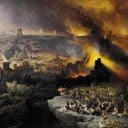The first of our introductory posts will be dealing with the literary styles and forms of literature used in the book or Revelation. The book is both unique in some respects but also employs common literary styles and themes. A little background information and knowledge on these styles will prove quite beneficial.
The first question that must be asked even before discussing the literary styles employed by the author is to determine under what category the literature resides? What makes John’s Revelation of Christ unique is that is an Epistle (letter), a Prophecy and an Apocalypse. These three different formats are merged in this single book making it completely unique in many respects.
EPISTLE
Quite plainly, the Revelation of Jesus Christ is a letter. In this way the book share commonality with other Biblical and Apostolic letters like we find employed in the New testament from Peter, James and, most notably, Paul. And like Paul, John addresses this letter to actual, physical, historical Churches that actually existed at the time of his writing.
This is significant!
Because these actual, historical churches are not only recipients of this letter, but are the ones it is actually addressed to, there must be some important and significant information in the letter that would be directed at and to them. This cannot be overlooked. John is quite plain when he states in the introduction…
Rev 1:4 John,
To the seven churches in the province of Asia:
Grace and peace to you from him who is, and who was, and who is to come, and from the seven spirits before his throne, 5and from Jesus Christ, who is the faithful witness, the firstborn from the dead, and the ruler of the kings of the earth.
Note both who this is being addressed to and where the message originates. John is declaring that this letter to the seven churches in Asia are receiving this correspondence from Jesus Christ Himself. With that in mind we MUST first consider the contents as it relates to those original readers BEFORE we decide to take the contents and remove it from the historical setting in which it is placed!
This practice is true with every Epistle. Many prophetic prognosticators have created a troubling predicament by taking truths that were addressed to a particular people at a particular time and transferring those truths to a contemporary setting where they may not belong. This book should be no different!
PROPHECY
This book is also a prophecy.
Though other New Testament epistles contain prophetic pronouncements the unique feature of the Revelation is that it is a Prophetic pronouncements. It will deal with things that had, at the time of the writing at least, not come to pass. This is made quite plain in the opening words of the book.
Rev 1:1 The revelation of Jesus Christ, which God gave him to show his servants what must soon take place. He made it known by sending his angel to his servant John, 2who testifies to everything he saw-that is, the word of God and the testimony of Jesus Christ. 3Blessed is the one who reads the words of this prophecy, and blessed are those who hear it and take to heart what is written in it, because the time is near.
As mentioned above other New Testament epistles contain prophetic pronouncements (1 Cor 15, 1 and 2 Thess, Titus, 1 and 2 John), but no other epistles states that the purpose of the letter is prophetic by it’s nature.
APOCALYPTIC
Though apocalyptic language is a “theme” or literary style, it is also a category of literature. It was a very common form of literature at the time of John’s writing as it was before and following the writing. It is not unique within the category of Apocalyptic category, but it is unique in that it is true!
What is meant by that is that other Apocalyptic writing were understood to be simply symbolic or fictional literature. Though employing the style of apocalyptic language, the Revelation is deterministically true. This sets it apart from the rest of the category and makes this writing unique. Though, by employing the literary techniques of the apocalyptic category it uses the following devices…
- Use of angels or spiritual guides
- Written during a time of great persecution of oppression
- Use of vivid imagery borrowed from other sources
- Uses numbers as symbols
- Uses symbols, numbers and imagery to represent individuals or peoples
There are two basic differences, though, between most apocalyptic treatises and the book of Revelation. The first discussed previously is that the Revelation of Christ actually predicts the future. The other is that the author identifies himself accurately. Most apocalytpic literature borrows a famous name and attaches it to the writing. Revelation is different as the author truly is the one who “saw” and testified to what he saw.
He made it known by sending his angel to his servant John, who testifies to everything he saw
This leads us to the most obvious question. Just who is this John that “saw” and “testified?” That we will deal with in the next post.





No comments:
Post a Comment